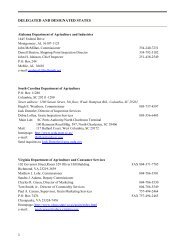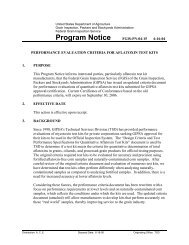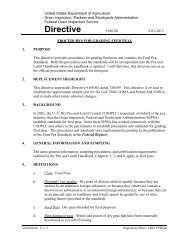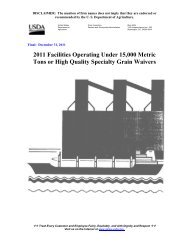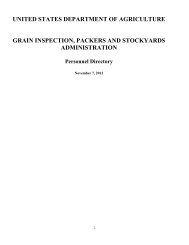Assessment of the Cattle and Hog Industries Calendar Year 2000
Assessment of the Cattle and Hog Industries Calendar Year 2000
Assessment of the Cattle and Hog Industries Calendar Year 2000
Create successful ePaper yourself
Turn your PDF publications into a flip-book with our unique Google optimized e-Paper software.
New-generation pork cooperatives seek to identify existing <strong>and</strong> new markets for swine,<br />
pork, <strong>and</strong> pork products, <strong>and</strong> to enter relationships with packers, processors, food service<br />
operations, retailers, <strong>and</strong> exporters to enhance <strong>the</strong> value <strong>of</strong> <strong>the</strong>ir members’ production.<br />
Many new-generation cooperatives develop systems <strong>and</strong> partnerships to maintain control<br />
<strong>of</strong> <strong>the</strong>ir product as far down <strong>the</strong> marketing chain as possible, including development <strong>of</strong> an<br />
independent producer br<strong>and</strong> or meeting requests for specialized products <strong>and</strong> packaging.<br />
They appear to do best when <strong>the</strong>y exploit a niche value-added market.<br />
New-generation cooperatives are more likely than traditional cooperatives to engage in<br />
partnerships, alliances, contract production, brokerage programs <strong>and</strong> o<strong>the</strong>r arrangements.<br />
They are also more apt to use new technologies like <strong>the</strong> Internet to create information<br />
linkages between producers <strong>and</strong> consumers, <strong>and</strong> to seek innovative financing techniques<br />
to exp<strong>and</strong> <strong>the</strong>ir capital base.<br />
New-generation cooperatives tend to be more difficult to join, but <strong>of</strong>ten easier to leave<br />
than traditional cooperatives. The substantial up-front investment producers need to make<br />
in new-generation cooperative stock is linked to delivery rights <strong>and</strong> responsibilities.<br />
Several pork organizations have proposed launching cooperative ventures. None <strong>of</strong> <strong>the</strong>se<br />
pork cooperatives, however, have opened a slaughtering facility.<br />
Packer Product Development<br />
Pork Marketing<br />
A focus on pork product development by packers has led to a trend away from<br />
commodity pork toward value-added br<strong>and</strong>ed pork products. Many traditional products,<br />
such as bacon <strong>and</strong> sausage, are now available in a pre-cooked or microwaveable form.<br />
Whole muscle products, especially loins, are available seasoned or marinated <strong>and</strong> readyto-cook.<br />
Ready-to-cook meals combining pork with o<strong>the</strong>r products, such as sausage <strong>and</strong><br />
biscuits or omelets <strong>and</strong> sausage, are readily available at grocery stores.<br />
E-commerce<br />
The pork industry, from small niche market firms <strong>and</strong> start-ups selling products directly<br />
to consumers to large packers selling to large grocery chains, has begun exploring <strong>the</strong><br />
potential <strong>of</strong> e-commerce. The biggest e-commerce development is <strong>the</strong> planned<br />
Commerce Ventures joint venture <strong>of</strong> Cargill, Inc., Farml<strong>and</strong> <strong>Industries</strong>, Inc., Gold Kist,<br />
Inc., IBP, inc., <strong>and</strong> Tyson Foods, Inc. This joint venture was discussed above in <strong>the</strong><br />
cattle section.<br />
28




